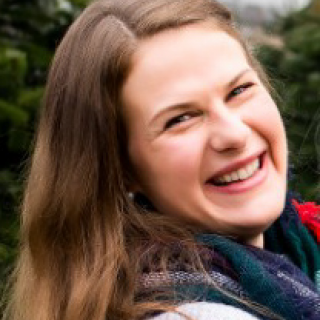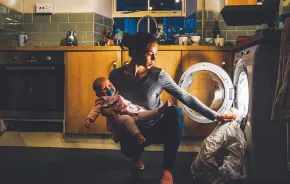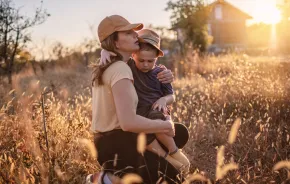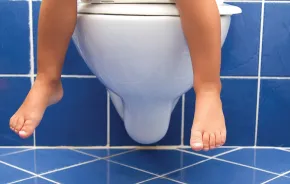
Photo:
Paige Pettibon
Paige Pettibon is a Tacoma-based artist whose heritage is Salish (from the Confederated Salish and Kootenai Tribes), Black and white. She shares her multicultural background with the community through art mediums that include acrylic painting, fiber art, beadwork, mural design and more. As a student and teacher of the Coast Salish Lushootseed language, Pettibon incorporates three virtues of Lushootseed culture into her art: being kind, being helpful and sharing. Murals she designed are on proud display at the new Kraken Community Iceplex and North Seattle Community College, and her beadwork is available for purchase through her Plain to Sea Instagram account.
We caught up with Pettibon to talk about her recent projects and the importance of art in bringing communities together.
How did you get your start as an artist?
Art is one of the most accessible forms of expression and communication for kids. My parents really facilitated art in our household. There were always books around as well as colored pencils, paper and markers. In middle school and high school, art was a really good way for me to express my feelings and emotions. A lot of us don’t have the words to articulate how we feel — or exercise tools like meditation to balance our lives — so art was something that was in my tool belt that I felt confident in; it made me feel really good. I am a visual artist, but I do poetry and creative writing to express how I feel. [Art has] always been an outlet for me to express myself creatively and give myself balance.
You create art in a variety of mediums — acrylic painting, beadwork, fiber art, murals, among them. What are you concentrating your time on right now?
In the beginning of the pandemic, I was getting some recognition in the art industry and had this big exhibition. I got the whole gallery to myself, and I curated it with work by my family and myself. We had two parties for the opening, and then nobody could see the exhibition because we went into lockdown.
After that, I shifted my focus to digital art. I got myself an iPad and I started working with the Procreate [graphics editor] app. It’s pretty user-friendly compared to other digital programs, and I watched a lot of YouTube videos. My partner self-studies in a lot of digital art, photography and 3D modeling, and he taught me how to use Adobe Illustrator. It’s really helpful in creating murals and designs quickly, where you want people to see what you can do. It’s been a good way for me to create art at home — I don’t have to wait for paint to dry or order supplies that are in high demand.
I don’t want to say I get bored, but I have this desire to not do one thing for a very long period of time. I have to get my hands dirty. I make jewelry all of the time. I try to be innovative with that, too. I use a lot of natural materials, such as shells or stones. I try to keep it current and fresh, and I push myself a little bit further.
Your murals at the Kraken Community Iceplex are beautiful, bold and striking! What was the inspiration for your designs and what do they represent?
Because it’s an iceplex, it will get chilly! [I wanted to convey] a warm-blanket feeling using some abstract, geometric shapes that are used for wool weaving. I was thinking about a spindle whorl, which is used to make wool. Coast Salish folks will decorate their spindle whorls with carving reliefs in forms: the crescent, trigon and animal shapes. Traditionally, we weave our regalia, robe or blanket, but weaving is often used throughout many cultures. You don’t have to be Coast Salish to have that relationship with wool weaving. It’s specific to here but something we can all share.
I was thinking about the relationship of Coast Salish masks and hockey masks, along with our youth and athleticism and how sometimes we can be really competitive. We want to be competitive in a healthy way that strengthens our athleticism, team skills and personal character, rather than “us against them” and isolating ourselves. I have a guardian mask to help us protect ourselves when we come to the space. We’ll be learning and making mistakes, and that’s what this place is for. I also have an endurance mask, because we need endurance to move forward, do this work and proceed in a good way. In one of the spindle whorls, I have four tentacles wrapped around an egg, [representing the protection of] our youth.
The woman holding her paddle up is one of my favorite parts — she could represent a lot of things, like Mother Earth, welcoming and maternal nurturing. She’s wearing a woven robe as well, [which] connects these abstract figures of wool weaving that are very angular and big so people can see the relationships.
I also like people to have their own interpretation — and have it change and be something they can have as part of their upbringing. I really think of the youth in these pieces: It’s important to have good images that make them feel welcome.
You’ve worked with kids, teaching art as a paraeducator at Chief Leschi Schools. How do you engage and inspire creativity in children?
I saw [how] public schools aren’t really set up to have kids be okay with failure, or not having the correct answer in a certain amount of time. That can harm a kid’s endurance — or their desire to solve problems. I think art was the best way for me to have them face those difficulties, but also feel a sense of pride in the work they put in. It’s visible and something they can touch and feel. Sometimes our emotions are hard to express, because they’re inside.
Socially, your sense of worth is how hard you work or what you produce and make: “Getting an A.” Art is subjective: It’s in the eye of the beholder. I can see the effort a child puts into the stripes they make with their markers. A lot of people have this idea about what art is, such as a perfect portrait. But if we take a step back and look at fine art, we have cubism and abstract art that’s highly regarded in the industry. Art can be anything; just taking the time to practice it daily can be really healing for our youth.
A lot of kids and Indigenous communities are really struggling, especially with COVID-19. [I want] to facilitate the desire to learn, to grow and to fail — because you’re trying something new.
You have an upcoming exhibit at the National Museum of the American Indian — can you tell us a little more about that?
It’s been a long process. The government in general takes a long time, because there are so many people who have to say yes — and they’re also adapting to a virtual exhibition. They’ll be showing two pieces of my art. The theme is “Ancestors Know Who We Are,” highlighting Afro-Indigenous artists. I’m really looking forward to showing my pieces there and having it be done. We’ve been talking about it since spring 2020!
If you like my work, I would suggest connecting with the yəhaw̓ Indigenous artist collective and just seeing things people in the community are doing. Yəhaw̓ is a Lushootseed word that means “to proceed and to do the work.” [The collective] originally started with the idea of having a large collection at the new King Street Station. They kept applying for grants, and it evolved to be an ongoing thing. They’ve already had workshops to support their artists, and they have mentorships and cohorts where teams work together. It does take longer when you can’t meet up as often, when you’re living on Zoom, but there will be an Afro-Indigenous exhibition and a broader exhibition, [at least] digitally, I believe.











